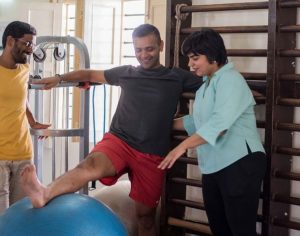Staying active is not a science.The key is to find activities that you enjoy—based on the four building blocks of fitness. These are:
Balance Exercises For Senior Fitness
What it is: Balance exercises help maintain standing and stability, whether you’re stationary or moving around. Try posture exercises to gain confidence with balance.
Why it’s good for you: It improves your balance, posture, and the quality of your walking. It also reduces your risk of falling or fear of falls.
Cardio Or Cardiac Rehabilitation Exercises
What it is: Cardiovascular exercise uses large muscle groups in rhythmic motions over a period of time. It gets your heart pumping and may even leave you feeling a little short of breath. Cardio workouts include Long walks at monitored pace, stair climbing, swimming, hiking, cycling.
Why it’s good for you: Cardio exercise helps lessen fatigue and shortness of breath. It also promotes independence by improving endurance for daily activities such as walking, house cleaning, and errands.
Strength and Power training
What it is: Strength training builds up muscle with repetitive motion using weight or external resistance from machines, free weights, elastic bands, or your own body weight. Power training is often strength training done at a faster speed to increase power and reaction times.
Why it’s good for you: Strength training helps prevent loss of bone mass, builds muscle, and improves balance—important for staying active and avoiding falls. Power training can improve your speed while crossing the street, for example, or prevent falls by enabling you to react quickly if you start to trip or lose balance. Building strength and power will help you stay independent and make day-to-day activities such as opening a jar, getting in and out of a car, and lifting objects easier.
Flexibility Programmes
What it is: Flexibility programmes challenge the ability of your body’s joints to move freely through a full range of motion. This can be done through stationary stretches or stretches that involve movement to keep your muscles and joints supple and less prone to injury.
Why it’s good for you: Flexibility helps your body stay limber and increases your range of movement for ordinary physical activities, such as looking behind while driving, tying your shoes, shampooing your hair, or playing with your grandchildren.





